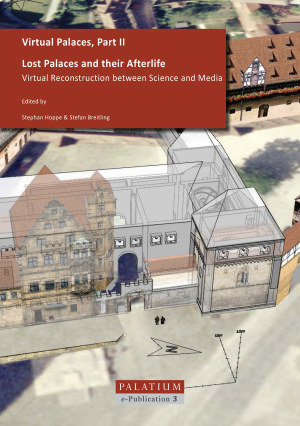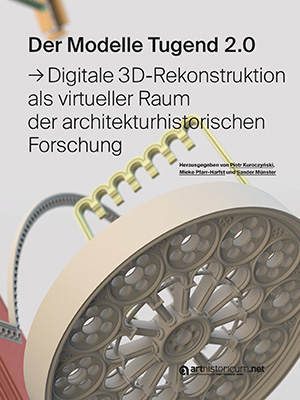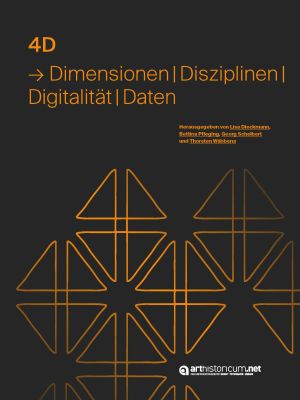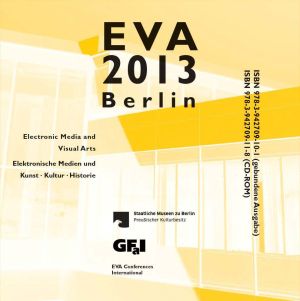Messemer, Heike
Digitale 3D-Modelle historischer Architektur: Entwicklung, Potentiale und Analyse eines neuen Bildmediums aus kunsthistorischer Perspektive
Digitale 3D-Modelle historischer Architektur ➔ Entwicklung, Potentiale und Analyse eines neuen Bildmediums aus kunsthistorischer Perspektive bietet erstmals einen umfassenden historischen Überblick über die Entstehungsgeschichte digitaler Architekturrekonstruktionen aus kunsthistorischer Perspektive. Zentrales Anliegen des Buchs ist es, anhand der kunsthistorischen Analyse digitaler 3D-Modelle Potentiale dieses neuen Bildmediums und Forschungswerkzeugs in den Geistes- und Kulturwissenschaften aufzuzeigen. Wesentliche Diskurse, Desiderate und Handlungsbedarfe in den Bereichen der Hypothesendarstellung, Dokumentation des Erstellungsprozesses und Langzeitarchivierung werden diskutiert. Der Wissenschaftscommunity bietet das Buch eine fundierte Grundlage für die Verortung digitaler 3D-Modelle historischer Architektur im Kontext von möglichen Forschungsfragen, wesentlichen Handlungsbedarfen und für die Initiierung von Impulsen für zukünftige Projekte.
Virtual Palaces, Part II: Lost Palaces and their Afterlife. Virtual Reconstruction between Science and Media
Der Band befasst sich mit der digitalen Rekonstruktion und Visualisierung von Schlössern, Burgen und Residenzarchitektur der Frühen Neuzeit. Das Hauptaugenmerk liegt dabei weniger darauf, digitale Modelle von noch bestehenden Gebäuden zu erstellen als vielmehr auf der virtuellen Rekonstruktion „verlorener“ Bauten, besonders bezogen auf Schlösser, die zerstört, stark umgebaut oder auch nie errichtet wurden.
Die 13 Aufsätze des Bandes wurden zuerst anlässlich des Palatium Workshops "Virtual Palaces, Part II" präsentiert, der im April 2012 in München stattfand.
Der Modelle Tugend 2.0: Digitale 3D-Rekonstruktion als virtueller Raum der architekturhistorischen Forschung
Der Modelle Tugend 2.0 – Digitale 3D-Rekonstruktion als virtueller Raum der architekturhistorischen Forschung fasst die digitale 3D-Rekonstruktion als Bestandteil einer interdisziplinären objektbezogenen Forschung auf. Handbuchartig werden übergreifende Methoden an der Schnittstelle zwischen Archäologie, Kunst- und Architekturgeschichte einerseits sowie Computergrafik und Kulturinformatik andererseits präsentiert und diskutiert. Zentrales Anliegen des Buches ist es, die Bandbreite des aktuellen wissenschaftlichen Diskurses zu digitalen 3D-Rekonstruktionen abzubilden und dabei sowohl bisherige Traditionen und Entwicklungslinien, den aktuellen Forschungs- und Praxisstand als auch künftige Herausforderungen und Desiderate darzustellen. Studierende, Wissenschaftlerinnen und Wissenschaftler wie auch interessierte Laien erhalten einen fundierten Überblick zum Themenfeld der digitalen 3D-Rekonstruktion im Feld der Architekturgeschichte. Der Fachcommunity bietet das Werk eine umfassende aktuelle Verortung und damit die Grundlage für die Identifizierung von zukünftigen Handlungsfeldern und Anregungen zu weiterführenden Diskursen.
4D: Dimensionen | Disziplinen | Digitalität | Daten
Vor 20 Jahren wurde prometheus als verteiltes digitales Bildarchiv für Kunstgeschichte und bildbasierte Disziplinen ins Leben gerufen und damit ein grundlegender Schritt für den digitalen Wandel in den jeweiligen Fächern vollzogen. Seitdem bilden sich die Konturen einer zukünftigen digital gestützten Wissenschaft deutlicher heraus. Die Digital Humanities erweitern das Methodenfeld der Geisteswissenschaften, interdisziplinäre Zusammenarbeit zur Beantwortung von Forschungsfragen setzt sich zunehmend durch und mit dem Aufbau einer Nationalen Forschungsdateninfrastruktur werden die Fundamente für ein sich im Wandel befindendes Wissenschaftssystem geschaffen.
Die Jubiläumstagung 2021 hat den Wandel der Wissenschaften unter vier Perspektiven (4D) diskutiert und ist bewusst über die Fachgrenzen der Kunstgeschichte hinausgegangen.
Bei dieser Publikation erscheinen die Beiträge sukzessive. Sie sind redigiert, im finalen Layout und werden unverändert in den Gesamtband übernommen. Jeder Early-View-Artikel erhält einen persistenten DOI und ist damit voll zitierfähig, es können lediglich noch keine Seiten angegeben werden. Erst wenn alle Beiträge vorliegen, werden sie mit Seitenzahlen versehen. Bitte verwenden Sie die im PDF angegebene Zitierempfehlung für den Early View. Neben dem E-Book (PDF) wird auch eine Printausgabe erscheinen.
Konferenzband EVA Berlin 2019. Elektronische Medien & Kunst, Kultur und Historie: 26. Berliner Veranstaltung der internationalen EVA-Serie Electronic Media and Visual Arts
„BASED ON TRUST! Kultur in Virtueller Umgebung“ ist das Schwerpunktthema der diesjährigen Konferenz. Es spielt auf das oszillierende Spannungsfeld an, das die digitale Transformation zwischen Datenidentität und Realpräsenz des Kulturerbes eröffnet hat. Sammlungsobjekte im Cyberspace, Konzerte und Performances als Datastreams, Kulturvermittlung in der VR – in allen Medien erweitern digitale Telepräsenztechnologien die Sichtbarkeit des kulturellen Erbes und generieren neue Kontexte, Narrative und Vermittlungsoptionen.
Aber lassen sich Glaubwürdigkeit und Einzigartigkeit der materiellen Evidenz der Objekte in den digitalen Datenströmen abbilden? Welche technischen Anforderungen verbinden sich mit der Erzeugung plausibler Szenarien und Atmosphären in der VR? Der Anspruch «Based on Trust» bezieht sich auf alle Bereiche der «Virtualisierung des Musealen», auf interpretierbare und zitierfähige Reproduktions- und Visualisierungstechniken in den 2D-, 3D-, Sound- und Videoformaten ebenso wie auf E-Installationen, explorative VR Anwendungen und KI. Authentizität und Glaubwürdigkeit ergeben sich in den digitalen Medien nicht von selbst. Sie erfordern vielmehr aufwendige Zuschreibungsprozesse und datenkuratorische Expertise. Die Berliner EVA Konferenz behandelt diese Themen an der Schnittstelle zwischen Gedächtnisinstitutionen, öffentlichen Verwaltungen, Technologieanbietern und Informationswissenschaftlern.
Konferenzband EVA 2013 Berlin Elektronische Medien & Kunst, Kultur, Historie 6. - 8. November 2013 in den Staatlichen Museen zu Berlin am Kulturforum Potsdamer Platz: Die 20. Berliner Veranstaltung der internationalen EVA-Serie Electronic Imaging & the Visual Arts (u. a. EVA London, EVA Florence, EVA Moscow & EVA Berlin)
-












